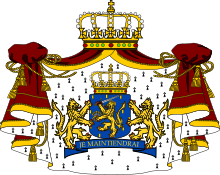Dutch flag & Coat of Arms
- Details
- Category: Facts Netherlands & Holland
The Greater Coat of Arms of the Realm, (or "Groot Rijkswapen"), is the personal coat of arms of the monarch of the Netherlands (currently Queen Beatrix).
 The government of the Netherlands uses a smaller version without the mantle (cloak) or the pavilion or sometimes even only uses the shield and crown. The components of the coats of arms were regulated by Queen Wilhelmina in a Royal decree of 10 July 1907 and were affirmed by Queen Juliana in a Royal decree of 23 April 1980.
The government of the Netherlands uses a smaller version without the mantle (cloak) or the pavilion or sometimes even only uses the shield and crown. The components of the coats of arms were regulated by Queen Wilhelmina in a Royal decree of 10 July 1907 and were affirmed by Queen Juliana in a Royal decree of 23 April 1980.
Description:
The blazon is follows:
Azure, billetty Or a lion with a coronet Or armed and langued Gules holding in his dexter paw a sword Argent hilted Or and in the sinister paw seven arrows Argent pointed and bound together Or. [The seven arrows stand for the seven provinces of the Union of Utrecht.] The shield is crowned with the (Dutch) royal crown and supported by two lions Or armed and langued gules. They stand on a scroll Azure with the text (Or) "Je Maintiendrai" (French for "I will maintain".)
The monarch places this coat of arms on a mantle gules lined with Ermine. Above the mantle is a pavilion gules again topped with the royal crown.
In the Royal decree it is stated that the male successors can replace the crown on the shield by a helm with the crest of Nassau. (For a description see below at "Nassau".)

The flag of the Netherlands is a horizontal tricolour of red, white, and blue. It harks back to Charlemagne's time. Variants of the flag have been in use since 1572 and in 1937 the flag was officially formalized as the national flag of the Netherlands and of the Kingdom of the Netherlands. It is the oldest tricolor flag. Description The national flag of the Netherlands is a tricolor flag. The horizontal fesses are bands of equal size in the colours, from top to bottom, red (officially described as a "bright vermilion"), white (silver), and blue ("cobalt blue"). The flag proportions (width:length) are 2:3. The first stadtholder of the Dutch Republic was William I of Orange, who joined with Dutch nationalists and led the struggle for independence from Spain. Partly out of respect for him, the first flag adopted by the Dutch was a horizontal tricolour of orange, white, and blue. It became known as the Prinsenvlag ("Prince's flag") and was based on the livery of William of Orange.[2] The orange dye was particularly unstable and tended to turn red after a while, so in the mid-17th century, red was made the official color. The flag has flown since then, but was confirmed by Royal Decree only in 1937, at the same time the colour parameters were exactly defined. As the first revolutionary flag, it has had a seminal influence throughout the world, particularly on the Pan-Slavic colors of Russia. Until about 1800, in the case of both the orange- and the red-striped versions, the number of stripes and their order frequently varied.
| Scheme | Bright Vermilion | White | Cobalt Blue |
|---|---|---|---|
| Chromatic | X=17.2 Y=9.0 Z=2.6 | N/A | X=7.8 Y=6.8 Z=26.7 |
| CMYK | 0.84.77.32 | 0.0.0.0 | 76.50.0.46 |
| RGB | (174,28,40) | (255,255,255) | (33,70,139) |
| Hexadecimal | #AE1C28 | #FFFFFF | #21468B |
